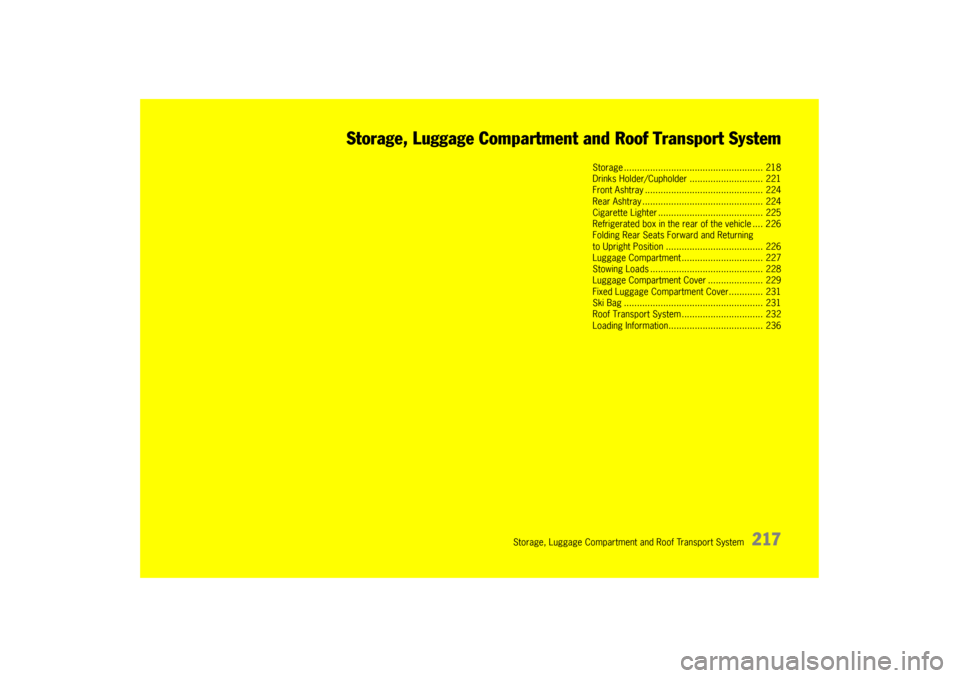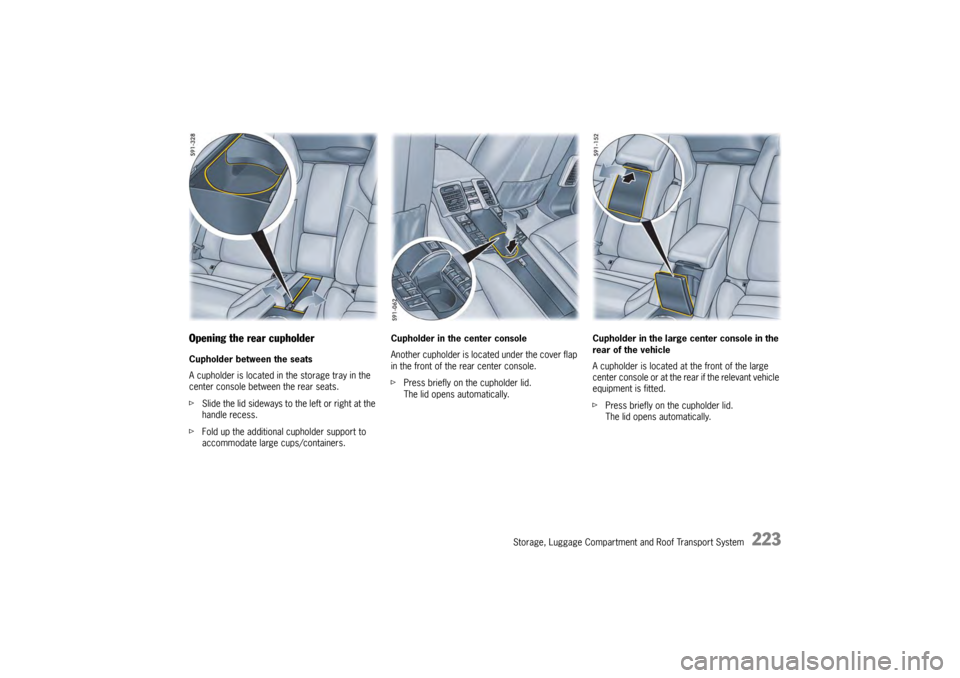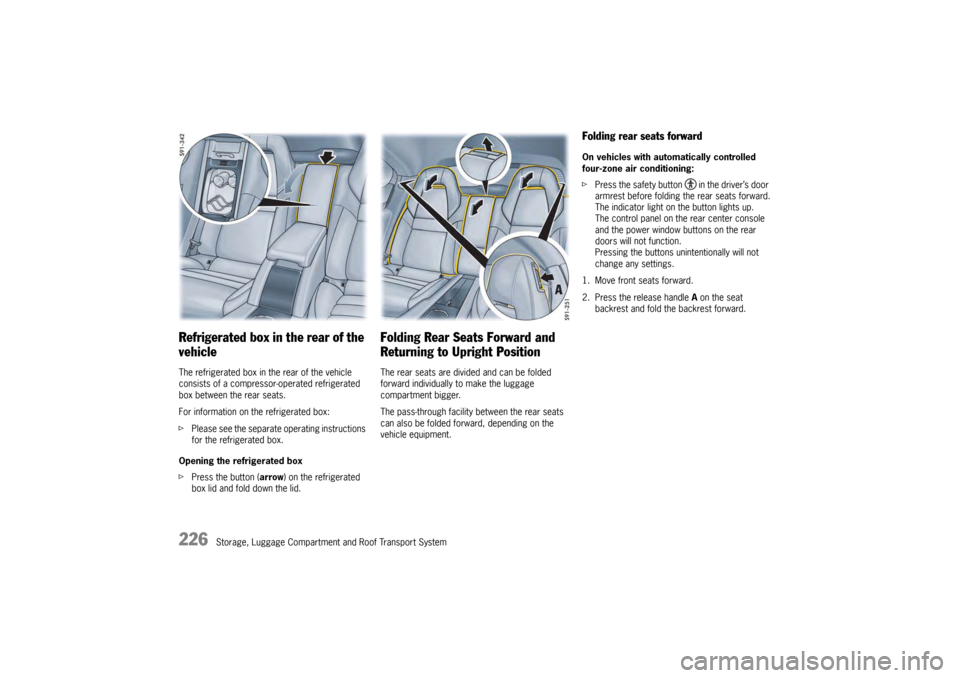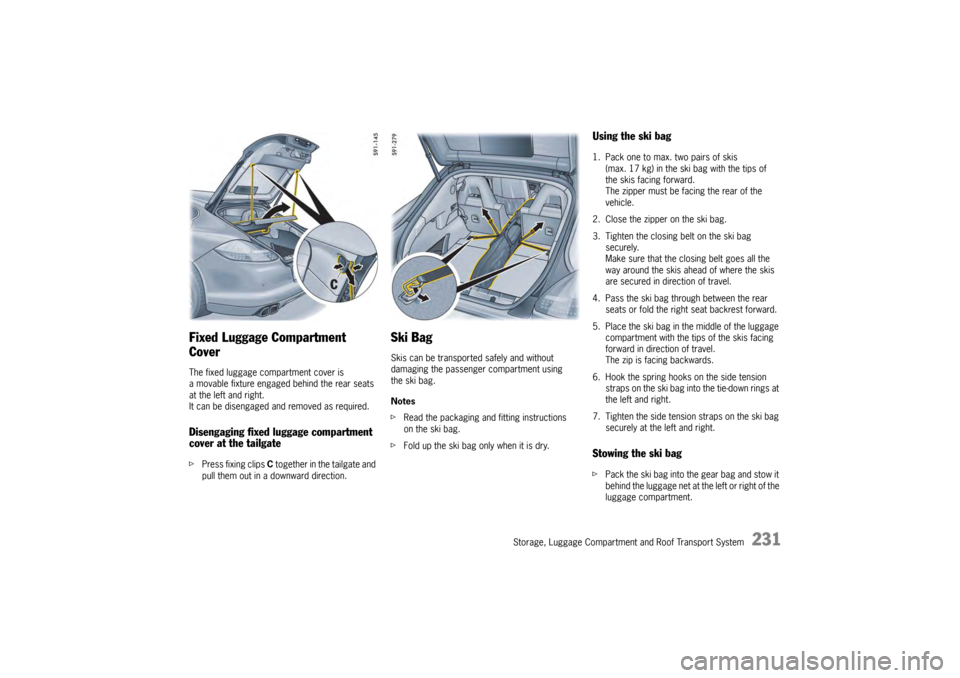2009 PORSCHE PANAMERA rear seats
[x] Cancel search: rear seatsPage 77 of 343

Air Conditioning
75
Setting automatic air-recirculation modeIn automatic air-recirculation mode, the fresh air
supply is adjusted depending on the air quality.
Automatic air-recirculation mode can be switched
on and off on the multi-function display.
At outside temperatures below approx. 50 °F
(10 °C), air-recirculation mode is deactivated
automatically to prevent the windows from
misting.
For information on adjusting automatic air-
recirculation mode on the multi-function display:
fPlease see the chapter “SETTING AIR
CONDITIONING” on page 146.
Note
The recommended operating mode is automatic
air-recirculation mode (default setting).
Information on the air-conditioning
compressorThe air-conditioning compressor:
– Can switch off briefly to ensure sufficient engine cooling if the engine is operating under
extreme load.
– Automatically switches off at temperatures below 38 °F (3 °C) and cannot be switched on,
even manually.
– Operates most effectively with the windows closed.
If the vehicle has been in the sun for a long
time, it is a good idea to ventilate the interior
briefly with the windows open.
– Depending on the outside temperature and humidity, condensation can drip from the
evaporator and form a pool under the vehicle.
This is normal and not a sign of leaks.
Information on automatic load switch-offIf the charging condition of the battery is critical,
the following air-conditioning or heating functions
are restricted initially and then switched off.
– Heated seats
– Heated rear window/External mirror heating
–Fresh-air blower
– Air-conditioning compressor
Page 219 of 343

Storage, Luggage Compartment and Roof Transport System
217
Storage, Luggage Compartment and Roof Transport System
Storage ...........................................
.......... 218
Drinks Holder/Cuphold er ............................ 221
Front Ashtray ............... .............................. 224
Rear Ashtray ................ .............................. 224
Cigarette Lighter ..... ................................... 225
Refrigerated box in the re ar of the vehicle .... 226
Folding Rear Seats Forward and Returning
to Upright Position .. ................................... 226
Luggage Compartment . .............................. 227
Stowing Loads ............. .............................. 228
Luggage Compartment Cover ..................... 229
Fixed Luggage Compartm ent Cover............. 231
Ski Bag ....................... .............................. 231
Roof Transport System ............................... 232
Loading Information. ................................... 236
Page 225 of 343

Storage, Luggage Compartment and Roof Transport System
223
Opening the rear cupholderCupholder between the seats
A cupholder is located in the storage tray in the
center console between the rear seats.
f Slide the lid sideways to the left or right at the
handle recess.
f Fold up the additional cupholder support to
accommodate large cups/containers. Cupholder in the center console
Another cupholder is located under the cover flap
in the front of the rear center console.
f
Press briefly on the cupholder lid.
The lid opens automatically. Cupholder in the large center console in the
rear of the vehicle
A cupholder is located at the front of the large
center console or at the rear if the relevant vehicle
equipment is fitted.
f
Press briefly on the cupholder lid.
The lid opens automatically.
Page 228 of 343

226
Storage, Luggage Compartment and Roof Transport System
Refrigerated box in the rear of the
vehicleThe refrigerated box in the rear of the vehicle
consists of a compressor-operated refrigerated
box between the rear seats.
For information on the refrigerated box:
fPlease see the separate operating instructions
for the refrigerated box.
Opening the refrigerated box
f Press the button (arrow ) on the refrigerated
box lid and fold down the lid.
Folding Rear Seats Forward and
Returning to Upright PositionThe rear seats are divided and can be folded
forward individually to make the luggage
compartment bigger.
The pass-through facility between the rear seats
can also be folded forward, depending on the
vehicle equipment.
Folding rear seats forwardOn vehicles with auto matically controlled
four-zone air conditioning:
f Press the safety button in the driver’s door
armrest before folding the rear seats forward.
The indicator light on the button lights up.
The control panel on the rear center console
and the power window buttons on the rear
doors will not function.
Pressing the buttons unintentionally will not
change any settings.
1. Move front seats forward.
2. Press the release handle A on the seat
backrest and fold the backrest forward.
Page 229 of 343

Storage, Luggage Compartment and Roof Transport System
227
Adjusting rear seats to vertical positionfMake sure that the seat belts are not trapped.
Fold up the backrest until it locks with an
audible click.
The red control stud B must be lowered
completely.
Warning!
Risk of injury. The rear seat back rest must
be kept locked when driving. When you
brake or in the event of an accident, objects
can slide into the passenger compartment
and endanger the occupants.
f Always lock rear-seat backrests securely.
Luggage CompartmentThe maximum permissible load on the loadspace
floor in the luggage compartment is 200 kg. The
weight must be distributed evenly over the entire
luggage compartment floor.
For information on stowing loads and luggage:
fPlease see the chapter “STOWING LOADS” on
page 228.Opening/closing the luggage
compartment floorfFold the luggage compartment floor up or
down using the handle ( arrow).
Tie-down ringsThe load can be secured in the luggage
compartment to prevent it from slipping by
fastening tie-down straps to the tie-down rings.
fMake sure that all ring s are equally loaded
when securing a load.
Note on operation
The tie-down rings are no t designed to restrain
a heavy load in an accident.
Page 230 of 343

228
Storage, Luggage Compartment and Roof Transport System
Stowing Loads
Danger!
Danger of injury. An unsecured or incorrectly
positioned load can slip out of place or
endanger the vehicle occupants during
braking, direction changes or in accidents.
Never transport objects that are not secured.
f Always transport loads in the luggage
compartment, never in the passenger
compartment (e.g. on or in front of the seats).
f Support the load against the seat backrests
wherever possible. Always lock the backrests
into place.
f Only transport heavy objects with the rear seat
backrests upright and engaged.
f Place the load behind unoccupied seats
whenever possible.
f Stow heavy objects as far forward as possible
on the floor, with lightweight objects behind
them.
f Never load the vehicle higher than the top
edge of the seat backrest.
f Always protect the passenger compartment
with a luggage compartment cover. Do not
drive with objects on top of the luggage
compartment cover. f
If the rear seats are not occupied, the
backrests can be addition ally secured with the
seat belts. Simply cro ss the outer seat belts
and insert each into the opposite buckle.
f Make sure that the load cannot damage the
heating filaments and the TV antenna in the
rear window.
Tie-down belts
f Do not use elastic belt s or straps to tie
down a load.
f Do not route belts and straps over
sharp edges.
f Observe the directions for use and information
for the tie-down equipment.
f Use only belts with a tear strength of at least
1543 lbs (700 kg) and a maximum width of
1 in. (25 mm).
f Cross the belts over the load. Driving
f
Vehicle handling changes depending on the
vehicle load. Adapt your driving style to the
changed driving behavior.
f Do not exceed the maximum gross weight
and axle load.
This information can be found under “Technical
data” in this Owner’s Manual:
f Please see the chapter “WEIGHTS” on
page 328.
f Never drive with the tailgate open. Exhaust
gases can enter the passenger compartment.
f Adapt the tire pressure to the load.
After you change the tire pressure, you must
also update the setting for Tire Pressure
Monitoring.
For information on setting Tire Pressure
Monitoring on the multi-function display:
f Please see the chapter “OVERVIEW OF
WARNING MESSAGES” on page 152.
Information on tire pressures for partially and fully
loaded vehicles can be found under “Technical
data” in this Owner’s Manual:
f Please see the chapter “TIRE PRESSURE FOR
COLD TIRES (68 °F/20 °C)” on page 326.
Page 233 of 343

Storage, Luggage Compartment and Roof Transport System
231
Fixed Luggage Compartment
CoverThe fixed luggage compartment cover is
a movable fixture engaged behind the rear seats
at the left and right.
It can be disengaged and removed as required.Disengaging fixed luggage compartment
cover at the tailgatefPress fixing clips C together in the tailgate and
pull them out in a downward direction.
Ski BagSkis can be transported safely and without
damaging the passenger compartment using
the ski bag.
Notes
f Read the packaging and fitting instructions
on the ski bag.
f Fold up the ski bag only when it is dry.
Using the ski bag1. Pack one to max. two pairs of skis
(max. 17 kg) in the ski bag with the tips of
the skis facing forward.
The zipper must be facing the rear of the
vehicle.
2. Close the zipper on the ski bag.
3. Tighten the closing belt on the ski bag securely.
Make sure that the closing belt goes all the
way around the skis ahead of where the skis
are secured in direction of travel.
4. Pass the ski bag through between the rear seats or fold the right seat backrest forward.
5. Place the ski bag in the middle of the luggage compartment with the tips of the skis facing
forward in direction of travel.
The zip is facing backwards.
6. Hook the spring hooks on the side tension straps on the ski bag into the tie-down rings at
the left and right.
7. Tighten the side tension straps on the ski bag securely at the left and right.Stowing the ski bagfPack the ski bag into the gear bag and stow it
behind the luggage net at the left or right of the
luggage compartment.
Page 238 of 343

236
Storage, Luggage Compartment and Roof Transport System
Loading InformationDefinitionsThe rear-axle load is the vehicle weight on the
rear axle plus the weight of the transported load.
The Curb weight - actual weight of your vehicle -
vehicle weight including standard and optional
equipment, fluids, and emergency tools. This
weight does not include passengers and cargo.
The Gross Vehicle Weight is the sum of the curb
weight and the weight of passengers and cargo
combined.
The Gross Vehicle Weight Rating is the
maximum total weight of vehicle, passengers,
luggage, hitch, trailer tongue load and optional
equipment.
The Gross Axle Weight Rating is the maximum
load limit for the front or the rear axle. This
information is located on the safety comliance
sticker located in the dr iver’s side door jamb.
For determining the compat ibility of the tire and
vehicle load capabilities:
f Please see the chapter “TIRES AND WHEELS”
on page 280. The load capacity coefficient (e.g. “106”) is a
minimum requirement. For more information:
f
Please see the chapter “INSCRIPTION ON
RADIAL TIRE” on page 288.
The Gross Combined Weight Rating is the
maximum total weight rating of vehicle,
passengers and cargo.
The Vehicle Capacity Weight - Load Limit - is
the maximum total weight limit specified of the
load (passengers and cargo) for the vehicle. This
is the maximum weight of passengers and cargo
that can be loaded into the vehicle. This infor-
mation can be found on the tire pressure plate.
The maximum loaded vehicle weight is the
sum of curb weight, acce ssory weight, vehicle
capacity weight and production options weight.
The load rating is the maximum load that a tire
is rated to carry for a given inflation pressure.
The maximum load rating is the load rating for
a tire at the maximum permissible inflation
pressure.
The cargo capacity is the permissible weight of
cargo, the subtracted weight of passengers from
the load limit.
f Never exceed the permissible limits.
Danger!
Risk of personal injury or death.
Injuries are much more likely in an accident
if persons ride in the cargo area.
f Persons must ride only on the seats provided
for this purpose.
f Make sure that everybody fastens their safety
belts.
Risk of loss of control, damage to the vehicle
and serious personal injury or death.
f Never exceed the specified axle loads.
Overloading can shorten the service life of the
tires and car, as well as lead to dangerous
vehicle reactions and long braking distances.
Damage due to overloading is not covered by the vehicle warranty.